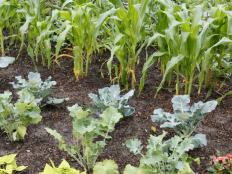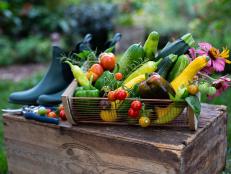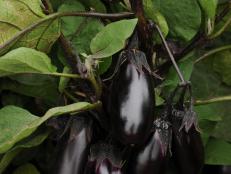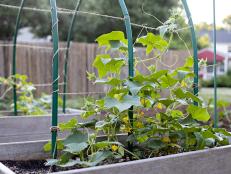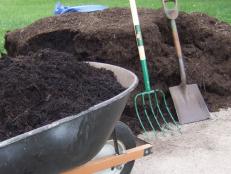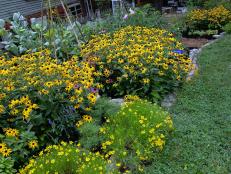Year-Round Gardener and Creative Genius: Niki Jabbour
See how this seasoned gardener grows fresh produce all year long.

Niki Jabbour is an author, blogger, radio host and gardening expert from Halifax, Nova Scotia. Known for her expertise in cold-weather gardening, she grows dozens of vegetable varieties in her 2,000-square-foot garden that she's able to harvest year round. Her first book, The Year Round Vegetable Gardener, focuses on tips and tricks to grow healthy edibles all year long, and her second title, Groundbreaking Food Gardens: 73 Plans That Will Change the Way You Grow Your Garden, opens your eyes to an infinite number of ways to grow your own food. Her radio program, The Weekend Gardener, is heard throughout Eastern Canada on News 95.7 FM and she blogs on Savvy Gardening, where she shares more gardening tips, DIYs and cold-weather gardening advice.

Storey Publishing Joseph De Sciose
Tell us a little about your work.
I’m a garden writer and radio host from Halifax, Nova Scotia which is located on the east coast of Canada where the growing season is short and winters are often cold and snowy. Yet, I still manage to harvest a wide range of crops 12 months a year in my food garden. In the winter, I rely on simple structures like cold frames and mini hoop tunnels, as well as straw mulch, to shelter cold season crops like kale, leeks, carrots, beets, scallions and dozens of types of salad greens.
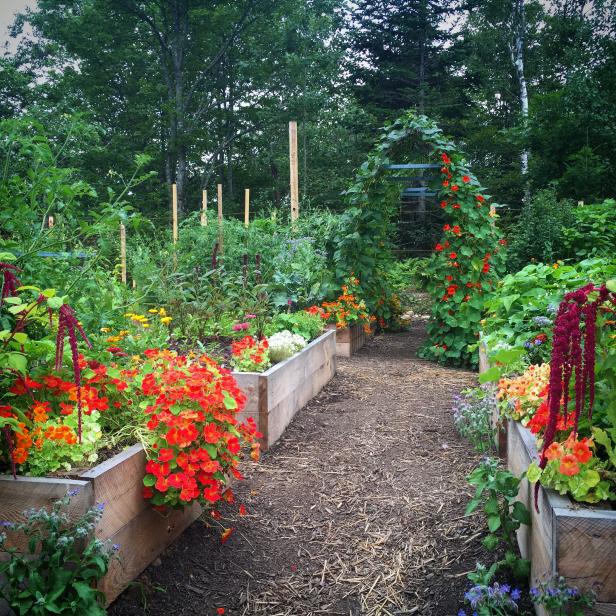
Storey Publishing
After gardening in the same space for 12 years, we underwent a major garden renovation in the spring of 2016. We bulldozed my existing garden, enlarged and leveled the area, and built 20 raised beds arranged in a symmetrical design. We also added vertical structures like tunnels and trellises to provide more growing space and surrounded the garden with an electric deer fence.
What is it like gardening in an area with a short growing season?

Excerpted from Niki Jabbour’s Veggie Garden Remix, © by Niki Jabbour, photography by © James Ingram/Jive Photographic Inc., used with permission from Storey Publishing
Growing up, our vegetable garden was a May to September garden with most of the harvest enjoyed in August and early September. Once I had my own garden and began experimenting, I realized it was possible to extend that season far beyond the early autumn limit and never looked back. I don’t see the frost dates as the beginning and end of the growing season anymore. Now, it’s all about growing the right crops in the right season and pairing them with the right season extenders.
What are some things that you do to help extend the garden season?

Excerpted from Niki Jabbour’s Veggie Garden Remix, © by Niki Jabbour, photography by © Philip Ficks., used with permission from Storey Publishing
My first season extender was a fabric row cover that allowed me to stretch our homegrown arugula harvest by weeks. Soon, I began building mini hoop tunnels over my raised beds for fall and winter harvesting. Some of my favorite cold season crops include kale, endive, leeks, broccoli, cabbage, lettuce, carrots, spinach and parsley. We grow a wide variety of food in our fall and winter garden beds and many, like kale and carrots, get sweeter as the temperature drops. Cold frames are the foundation of our winter garden and mine measures 3' x 6'. They are topped with Lexan which has a double layer of polycarbonate for added insulation. These structures capture solar energy and create a microclimate around our vegetables. In mid-winter when the garden is hidden beneath a blanket of snow, it’s amazing to lift the cover of a cold frame and pick a big bowl of winter greens and root crops.
I also use my season extenders, like mini hoop tunnels, so I can plant heat-loving, long-season crops like ground cherries, eggplants and peppers earlier in the spring. However, in recent years, our climate has begun to change and our summers have definitely gotten longer and warmer.
What is the biggest challenge to gardening in the winter (besides cold weather)?
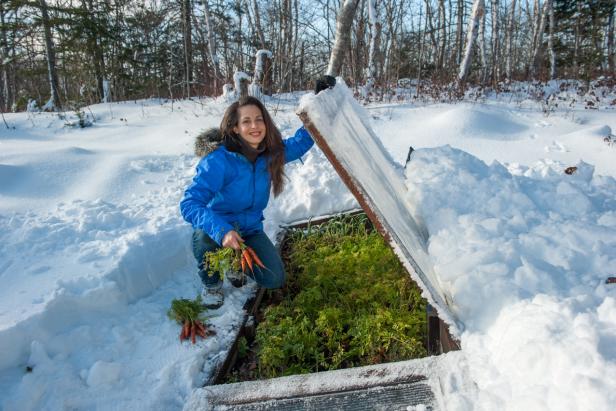
Storey Publishing Joseph De Sciose
Early on, I found the biggest challenge was finding seeds for my winter garden. Many companies didn’t stock the vegetables or varieties I wanted to grow: mache, mizuna, claytonia, tatsoi and so on. Thankfully, with the popularity of food gardening and year-round vegetable gardening, it’s become much easier to source these seeds and I can even buy them at my local seed companies.
Otherwise, I’ve found the winter garden to be incredibly low maintenance. Picking the right crops to grow is very important. For example, Swiss chard is a fall garden superstar but tends to succumb to the frigid temperatures in our garden by December. Therefore, I plant it as a late fall crop, and also again in early spring for an April-May harvest, but I don’t give it space in our winter harvest beds. Instead, I save that precious garden space for the cold-hardy vegetables and herbs that we can harvest all winter long.
Are there pests or diseases that cool/cold weather plants are more susceptible to?
For me, the cold season is a quiet time in the garden. It’s the only time I don’t fight the deer — they can’t reach the crops under mulch, cold frames or mini hoop tunnels — and there are no slugs and other pests. Even insects like aphids aren’t an issue when the temperature is freezing. The same applies to diseases. In spring and fall, I make sure to vent my structures often by propping open the tops of the cold frames or clipping up the ends of the mini hoop tunnels to allow good air circulation. But in winter, the bacteria or fungi that cause most common garden diseases are inactive or have been killed by the cold temperatures. I also don’t have to water or weed and the only tasks are harvesting and brushing the snow off the structures after a snowstorm.

Excerpted from Niki Jabbour’s Veggie Garden Remix, © by Niki Jabbour, photography by © James Ingram/Jive Photographic Inc., used with permission from Storey Publishing
What are some tips you can offer to someone who wanted to give winter gardening a shot?
The easiest way to start stretching your season is with mulch. In late autumn, before the ground freezes, mulch any root or stem crops (leeks, carrots, beets, celeriac, etc) left in your garden beds with a 12 to 18-inch-deep layer of shredded leaves or straw. Then, top the mulch with an old row cover or bedsheet to hold the insulation in place. We harvest from our mulched beds all winter long.
It’s also very easy to build a mini hoop tunnel from 1/2-inch diameter PVC conduit. These are arched over a garden bed and secured to the ground over one-foot-long rebar stakes. A mini tunnel takes me about 10 minutes to build and is a great way to overwinter taller crops like kale, collards, leeks and other salad greens. Cover the hoops with clear plastic and weigh the plastic down with rocks or logs. If you get a lot of snow in your region, run a wooden board (like a 1x2 piece of lumber) down the center of the structure before you put on the cover to help shed snow. In winter, you can lift the ends of the tunnel and harvest your bounty of greens.
What can we look forward to in your new book?
Veggie Garden Remix celebrates diversity in the garden and spotlights some of my favorite unusual, global or uncommon edibles like burr gherkins, cucamelons, Inca berries, chickpeas, Yukina savoy, celtuce and about 235 other awesome crops. It was inspired by my mother-in-law, a Lebanese immigrant who taught me to flex my gardening skills and try growing new-to-me Middle Eastern crops like edible gourds, purslane and zaatar. Oh, the meals that we now enjoy! I hope that everyone who loves to experiment in their gardens joins me on this global food journey.







